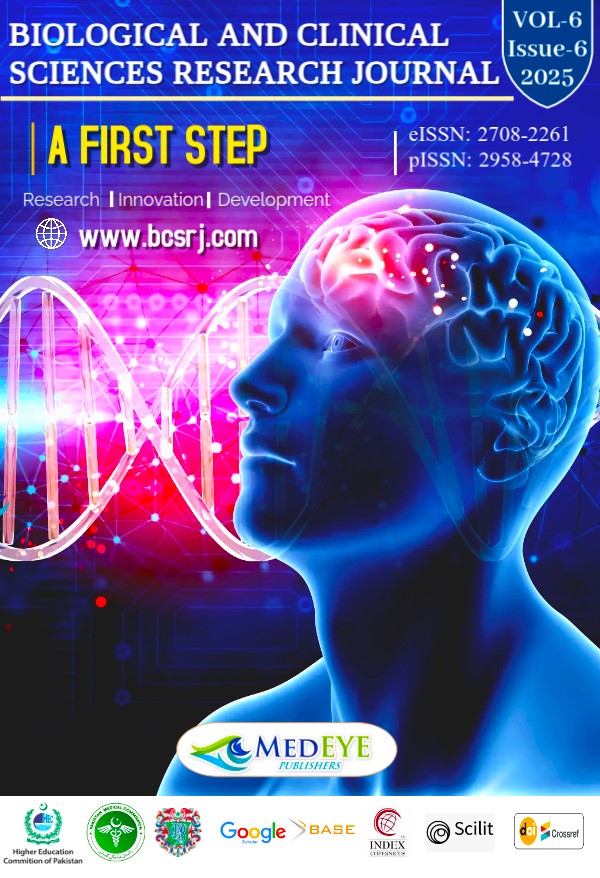Comparative Efficiency of APRI vs. FIB-4 in Detecting Advanced Liver Fibrosis in NAFLD and NASH
DOI:
https://doi.org/10.54112/bcsrj.v6i6.1874Keywords:
Non-alcoholic Fatty Liver Disease, Liver Cirrhosis, Fibrosis, Elastography BiomarkersAbstract
Non-alcoholic fatty liver disease (NAFLD) and non-alcoholic steatohepatitis (NASH) are significant causes of chronic liver disease, with the progression to advanced fibrosis (F3–F4) significantly impacting prognosis. Objective: To compare the diagnostic accuracy of APRI and FIB-4 scores in detecting advanced liver fibrosis (F3–F4) in NAFLD and NASH patients, using transient elastography (FibroScan) as the reference standard. Methods: This cross-sectional, observational study was conducted at Fauji Foundation Hospital from March 2024 to March 2025. A total of 120 adult patients aged between 18 and 70 years with a confirmed diagnosis of NAFLD or NASH were included in the study. All data were collected using a standardized form. Variables recorded included patient demographics (age, sex, body mass index), comorbidities such as diabetes and hypertension, and relevant laboratory values, specifically serum AST, ALT, and platelet counts. Results: Out of 120 patients, 42 (35%) had advanced fibrosis on fibroscan. The FIB-4 score showed superior diagnostic performance with an AUROC of 0.86 (95% CI: 0.79–0.91), sensitivity of 78.5%, specificity of 85.9%, PPV of 75.6%, and NPV of 87.5%. APRI showed an AUROC of 0.79 (95% CI: 0.71–0.86), sensitivity of 71.4%, specificity of 80.8%, PPV of 66.7%, and NPV of 84.4%. Subgroup analysis confirmed the consistent superiority of FIB-4 across age and diabetic status. FIB-4 also had a lower misclassification rate (15.8%) compared to APRI (21.7%). Conclusion: It is concluded that while both APRI and FIB-4 are practical non-invasive tools for assessing liver fibrosis in NAFLD/NASH, FIB-4 is more accurate in detecting advanced fibrosis. Its greater diagnostic power and stability across subgroups support its use as the preferred first-line fibrosis assessment tool in routine clinical practice.
Downloads
References
Nielsen MJ, Leeming DJ, Goodman Z, Friedman S, Frederiksen P, Rasmussen DGK, Vig P, Seyedkazemi S, Fischer L, Torstenson R, Karsdal MA, Lefebvre E, Sanyal AJ, Ratziu V. Comparison of ADAPT, FIB-4 and APRI as non-invasive predictors of liver fibrosis and NASH within the CENTAUR screening population. J Hepatol. 2021 Dec;75(6):1292-1300 https://doi.org/10.1016/j.jhep.2021.08.016.
Brown EA, Minnich A, Sanyal AJ, Loomba R, Du S, Schwarz J, Ehman RL, Karsdal M, Leeming DJ, Cizza G, Charles ED. Effect of pegbelfermin on NASH and fibrosis-related biomarkers and correlation with histological response in the FALCON 1 trial. JHEP Rep. 2023 Jan 7;5(4):100661. https://doi.org/10.1016/j.jhepr.2022.100661 .
Chalasani N, Younossi Z, Lavine JE, Charlton M, Cusi K, Rinella M, et al. The diagnosis and management of nonalcoholic fatty liver disease: practice guidance from the American Association for the Study of Liver Diseases. Hepatology. 2018;67:328–57. http://doi.org/10.1002/hep.29367
Hagstrom H, Nasr P, Ekstedt M, Hammar U, Stal P, Hultcrantz R, et al. Fibrosis stage, but not NASH, predicts mortality and time to development of severe liver disease in biopsy-proven NAFLD. J Hepatol. 2017;67:1265–73. http://doi.org/10.1016/j.jhep.2017.07.027
Taylor RS, Taylor RJ, Bayliss S, Hagstrom H, Nasr P, Schattenberg JM, et al. Association between fibrosis stage and outcomes of patients with nonalcoholic fatty liver disease: a systematic review and meta-analysis. Gastroenterology. 2020;158:1611–25.e12. http://doi.org/10.1053/j.gastro.2020.01.043
Estes C, Razavi H, Loomba R, Younossi Z, Sanyal AJ. Modeling the epidemic of nonalcoholic fatty liver disease demonstrates an exponential increase in the burden of disease. Hepatology. 2018;67:123–33. http://doi.org/10.1002/hep.29466
Noureddin M, Sanyal AJ. Pathogenesis of NASH: the impact of multiple pathways. Curr Hepatol Rep. 2018;17:350–60. http://doi.org/10.1007/s11901-018-0425-7
Dufour JF, Caussy C, Loomba R. Combination therapy for non-alcoholic steatohepatitis: rationale, opportunities and challenges. Gut. 2020;69:1877–84. https://doi.org/10.1136/gutjnl-2019-319104
Loomba R. Role of noninvasive biomarkers in the diagnosis of nonalcoholic steatohepatitis with stage 2 or 3 fibrosis. Gastroenterol Hepatol (N Y). 2020;16:139–41.
Ratziu V, Charlotte F, Heurtier A, Gombert S, Giral P, Bruckert E, et al. Sampling variability of liver biopsy in nonalcoholic fatty liver disease. Gastroenterology. 2005;128:1898–906. https://doi.org/10.1053/j.gastro.2005.03.084
Davison BA, Harrison SA, Cotter G, Alkhouri N, Sanyal A, Edwards C, et al. Suboptimal reliability of liver biopsy evaluation has implications for randomized clinical trials. J Hepatol. 2020;73:1322–32. http://doi.org/10.1016/j.jhep.2020.06.025
Alkhouri N, Tincopa M, Loomba R, Harrison SA. What does the future hold for patients with nonalcoholic steatohepatitis: diagnostic strategies and treatment options in 2021 and beyond? Hepatol Commun. 2021;5:1810–23. https://doi.org/10.1002/hep4.1814
Heyens LJM, Busschots D, Koek GH, Robaeys G, Francque S. Liver fibrosis in non-alcoholic fatty liver disease: from liver biopsy to non-invasive biomarkers in diagnosis and treatment. Front Med (Lausanne). 2021;8. http://doi.org/10.3389/fmed.2021.615978
Castera L, Friedrich-Rust M, Loomba R. Noninvasive assessment of liver disease in patients with nonalcoholic fatty liver disease. Gastroenterology. 2019;156:1264–84.e4. http://doi.org/10.1053/j.gastro.2018.12.036
Erhardtsen E, Guldager D, Rasmussen K, Manon-Jensen T, Frederiksen P, Leeming D, et al. The liver fibrosis marker PRO-C3 increases with fibrosis stage and is neither elevated in people with diabetes without liver disease nor in healthy obese subjects. J Hepatol. 2021;75:S573.
Luo Y, Oseini A, Gagnon R, Charles ED, Sidik K, Vincent R, et al. An evaluation of the collagen fragments related to fibrogenesis and fibrolysis in nonalcoholic steatohepatitis. Sci Rep. 2018;8. http://doi.org/10.1038/s41598-018-30457-y
Bril F, Leeming DJ, Karsdal MA, Kalavalapalli S, Barb D, Lai J, et al. Use of plasma fragments of propeptides of type III, V, and VI procollagen for the detection of liver fibrosis in type 2 diabetes. Diabetes Care. 2019;42:1348–51. http://doi.org/10.2337/dc18-2578
Jensen C, Holm Nielsen S, Eslam M, Genovese F, Nielsen MJ, Vongsuvanh R, et al. Cross-linked multimeric pro-peptides of type III collagen (PC3X) in hepatocellular carcinoma—a biomarker that provides additional prognostic value in AFP-positive patients. J Hepatocell Carcinoma. 2020;7:301–13. http://doi.org/10.2147/JHC.S275008
Loomba R, Neuschwander-Tetri BA, Sanyal A, Chalasani N, Diehl AM, Terrault N, et al. Multicenter validation of the association between decline in MRI-PDFF and histologic response in NASH. Hepatology. 2020;72:1219–29. http://doi.org/10.1002/hep.31121
Downloads
Published
How to Cite
Issue
Section
License
Copyright (c) 2025 Sadaf Noureen, Hareem Fatima, Amina Hasan Butt, Abeeha Zia, Muhammad Huzaifa Abid, Iqra Malik

This work is licensed under a Creative Commons Attribution-NonCommercial 4.0 International License.









